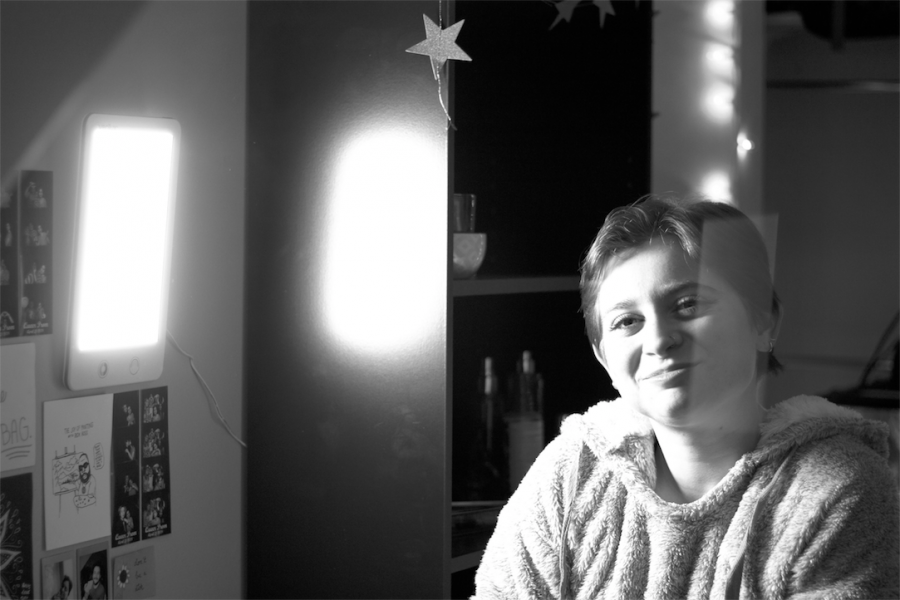Seasonal Sadness: Winter Woes
Junior Tali Friedman uses “light boxes” that emit bright light which simulates daytime sunlight levels to combat feelings of depression that come during the winter months. Thirty minutes of exposure to light therapy on a daily basis can provide symptom relief to many sufferers.
February 15, 2019
It’s a Sunday afternoon, and junior Tali Friedman opens her windows to watch an early sunset.
Then, she turns on her light box, a special lamp on her wall that mimics sunlight and helps her combat seasonal depression.
“Winters in Vermont can be intense,” Friedman said. “Literally, with the amount of snow, but also emotionally.
“Socially, people feel withdrawn. The lack of light can be difficult. But people cozy up and pull out their sweaters.”
Vermont is known for its lengthy, frigid winters. During these winter months, students take advantage of outdoor winter recreation and enjoy the snowy scenery.
Senior Emily Bruggeman said she finds the harsh winters in Vermont invigorating. She enjoys the four distinct seasons in New England.
“[Winter is] the necessary shift in environment to keep things truly lively and fresh,” she said.
However, the lower levels of sunlight and colder temperatures take a toll on the mental health of many students.
For some students, the short days are the most devastating aspect of winter. Many have schedules that require them to be most active with clubs, jobs and extracurricular activities long after the sun has set in the midafternoon.
Senior Wyatt Garratt said the early nights remind him of the 2007 film “30 Days of Night,” which takes place in Alaska during a month-long period in which the sun does not rise.
“Sometimes, I’m just in a fugue,” he said.
English professor Major Jackson has lived in Vermont for 16 years and relies on a series of routines that help him keep a positive attitude.
“The winters at times come really strong — a lot of snow, cold temperatures, subarctic air. So I believe in soup, and I believe in lots of candles. I am totally down with the hygge [a Scandinavian concept of comfort and coziness],” he said.
He also emphasized the importance of spending quality time with friends in the winter, enjoying gatherings with friends for wine and dessert, storytelling or even reading aloud works of literature about the winter season.
“[I rely on] any kind of ritual or activity that helps me say ‘OK, this is not abnormal that the temperature has windchill factors of minus 21,’” he said.
For many, enjoying the snowy season requires a shift in lifestyle and focus on self-care.
“Sometimes I like to stay busy, sometimes I like to not have as much planned. Listen to yourself. Figure out what needs to be prioritized,” Friedman said.
“Winter has always been the hardest for me, but I also feel that it can be fun or transformative, even.”
For some students, the issue goes beyond dull feelings of sadness in the winter. Low levels of sunlight can cause seasonal depression in some individuals, according to the Mayo Clinic.
The symptoms of seasonal depression, also known as Seasonal Affective Disorder, typically appear in fall or the early winter and continue until spring begins.
Symptoms include feelings of depression, low energy, changes in sleep patterns, changes in appetite and problems with concentration. These symptoms can be devastating and heavily disruptive to the lifestyle of those affected.
Treatment for this condition can involve counselling, antidepressant medication or even light therapy — using light boxes that emit bright light which simulates daytime sunlight levels, according to the Mayo Clinic.
These light boxes are much brighter than everyday indoor lighting and help trick the brain into thinking it’s daytime, according to an October 2015 Harvard Health article. This helps regulate the body’s circadian rhythm, making the days seem longer and improving mood.
Thirty minutes of exposure to light therapy on a daily basis can provide symptom relief to many living with SAD.
“[Light boxes] help with circadian rhythms. They make it seem like your room is lit up like it’s the day,” Friedman said. “It definitely helps when the sun goes down early.”
The lamps retail for around $90 on Amazon. Those curious about the therapeutic effects of these lights can try them out in the Living Well office in the Davis Center, which is open from 8:30 a.m. to 4:30 p.m. Monday through Friday.
Sofia Khanayev, a Living Well staff member, said the happy lights are specifically used for SAD.
“They basically simulate the light of the sun,” she said. “They’re really helpful for those cold, dreary days.”
Whether students are struggling with seasonal mood changes or have a deeper underlying mental health concern, there are many resources at UVM for students struggling during the winter months through Living Well and Counseling and Psychiatry Services.
“At Living Well, we have a lot of programs that help you with self-care. We have ‘Let’s Talk’ with Counseling and Psychiatric Services counsellors — basically drop-in consultations with CAPS counsellors — Monday to Thursday from noon to 2 p.m.,” Khanayev said.
Students struggling to cope with the winter months should know that they aren’t alone.
As the campus forges through the toughest stretch of the spring semester, there is still plenty of light to be found, even on the shortest days.







